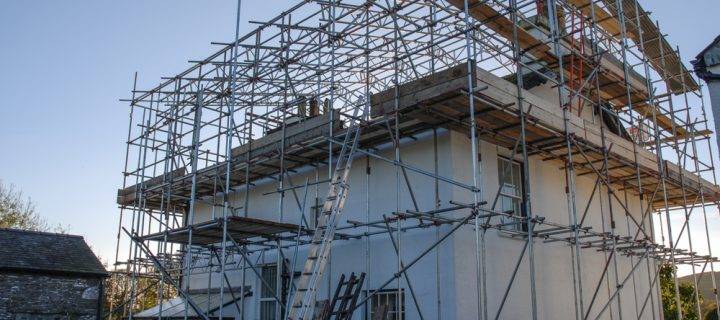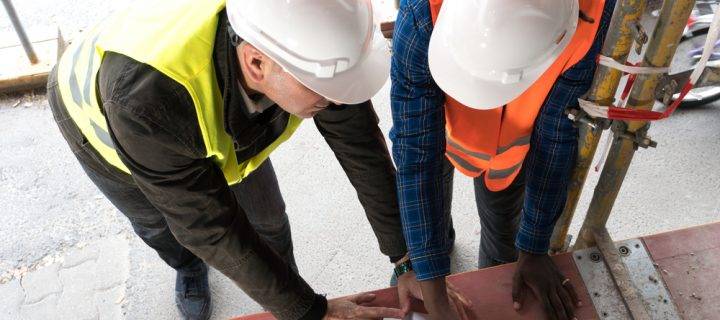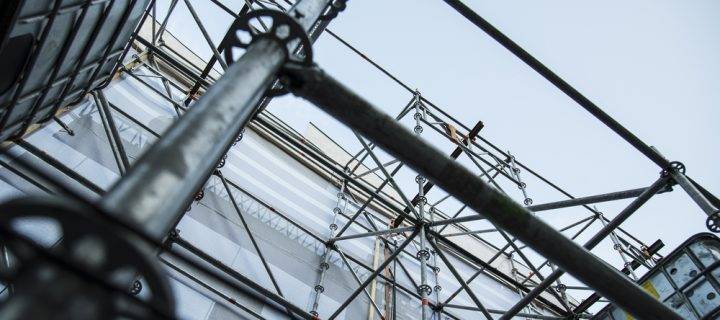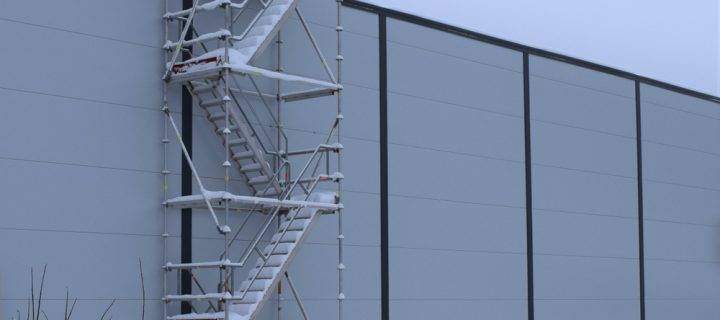Temporary roof scaffolding and covering help to guard your building’s structure when you need to repair tiles or have a leak in your roof. Here in the U.K, we have plenty of rainy days, so if you are waiting for a new roof to be installed on your property you simply can’t expose it to the elements. For our latest blog, our team of specialists are going to explore temporary roofing in more detail and explain how it works with scaffolding. How Scaffolding Temporary Roofs Work Most temporary roofs are put together in sections on the ground and then lifted into place by a crane, which reduces the amount of working at height plus it is quicker and more cost-effective. Encapsulating the sides gives your roofing a watertight finish meaning that work can continue throughout the year without the fear of any stoppages due to adverse weather. One of the most common temporary roofs specified is the UBIX system, which allows safe installation by feeding the sheeting through runners from the scaffold on either side of the structure. Here is a breakdown of the basics of the UBIX system – The light and the aesthetic weather-resistant roof is quick to assemble It can be built as a mono or duo pitch roof The roof opens to allow materials to be craned through Temporary roofs can be used as a mobile roof structure They usually span up to 15m, but greater spans are available from different suppliers Network Scaffold – The Construction Specialists Network Scaffold has been the leading the providers of scaffold and access scaffolding for projects right across Staffordshire, Nottinghamshire, Derbyshire and Loughborough for a number of years. Our hands-on approach with our clients makes us the first choice for domestic and commercial construction projects. With the recent Storm Brendan ravaging all parts of the country, you may require scaffolding to help with repairs on your property. Contact Us Today for More Information If you have any questions about our scaffold services, please contact us...
Read Moreabout Using Temporary Roofing with ScaffoldingThe country is preparing for a barrage of unpredictable weather as Storm Brendan descends on us; but what should you do with your scaffolding? The Met Office has warned of winds up to 80mph, with a weather warning issued across Monday 13th and Tuesday 14th January. Simon Partridge, Forecaster at The Met Office commented, “As it pushes through, pretty much every part of the UK will feel the influence.” Network Scaffold puts the health and safety of our clients at the forefront of our work; which is why we are sharing some handy safety tips in our latest post. Essential Scaffolding Tips to Follow Here are 8 tips for construction workers when working with scaffolding – Construction workers should never climb on scaffolds that wobble or leans to one side Before mounting the scaffold, it needs to be inspected very carefully and should not be used if a pulley, hook, block or fitting is worn out, rusted, cracked or damaged in a different manner If the scaffold has been tagged as out of service, you should stay away from it The scaffold should not be supported using objects such as bricks, blocks, barrels or boxes Guardrails or flooring need to be in the right place before being used Scaffolding should be levelled after every corner, with the adjusting leg screws shouldn’t be extended beyond 12 inches Workers on scaffolds raised above 10 feet from the ground should be worn with safety belts Your team should keep both the feet on the deck and should not sit or climb on the guardrails Want to Find Out More? Contact Us Today If you have any questions about working around weather conditions such as Storm Brendan, please get in touch today or alternatively, read our FAQ section. Network Scaffold is the leading scaffolding providers for Derbyshire, Nottinghamshire, Loughborough and...
Read Moreabout Preparing for Storm Brendan with Network ScaffoldOne of the biggest construction projects to take place in Tamworth in 2020, will be the transformation of Tamworth Castle. Like so many other redevelopment projects, investing in the finest scaffolding in Tamworth from Network Scaffold is the only way to guarantee the best possible result. Building the Future of our Heritage The new-look Tamworth Castle will transform the top floor with an interactive exhibition dedicated to the town’s rich Anglo-Saxon heritage. The ‘Battle and Tribute’ display will turn the space into a mead hall, an immersive combat film experience and a unique touch-table battle strategy game. Tamworth Castle will also be getting more pieces of the Staffordshire Hoard to display alongside items with the castle’s collection. The top floor of the ancient castle is being transformed and improved, including upgrades to the infrastructure, a new ceiling and lighting plus restorative work to walls and windows. All of this work will make way for the installation of the new gallery, ready for opening in 2020. Cllr Jeremy Oates, Tamworth Borough Council’s Cabinet member for Heritage and Growth, commented on the project, saying, “The plans for the state-of-the-art Battle and Tribute gallery are very impressive and unlike anything we’ve had at the castle before. “It will really bring our rich Anglo-Saxon history to life, including the role of our famous warrior queen Aethelflaed, and will be the perfect showcase for an increased number of items from the Staffordshire Hoard and how this incredible treasure trove fits into the wider history of the Kingdom of Mercia and beyond.” How Quality Scaffolding Helps Large and Small Scale Projects Network Scaffold has been providing scaffolding services right across the Midlands (including Tamworth) for a number of years. We work with clients on both domestic and commercial projects, following the latest health and safety regulations for the industry. If you would like to know more about scaffolding services, please contact us...
Read Moreabout Championing History with ScaffoldingHere at Network Scaffold, we understand the importance of having the right qualifications before starting a career in scaffolding. You can begin at entry level as a scaffolding labourer or trainee without formal qualifications, and through on-going training and industry recognised courses carve a career out within the industry. The UK scaffolding sector is made up of thousands of companies of all shapes and sizes. Network Scaffold understands the importance of developing younger staff, which is the reason we are part of the Scaffolding Association, which also helps us to constantly improve our practice to be the best in the industry. With safety in mind, we are also accredited by Safety Schemes in Procurement and recognised as a SMAS Worksafe Contractor. Training Tips for Budding Scaffolders If you are considering a career in scaffolding, here are some essential tips to help you succeed and reach your full potential. Choose the right course and training provider – When deciding which course to enrol onto, you need to make sure the training you will receive is of the highest standard and leads to recognised and relevant qualifications. Scaffolding apprenticeships aren’t age-restricted, meaning anyone can start a course if they choose to. Scaffolding places a large emphasis on English and Mathematics, so having existing qualifications in these areas is also beneficial. Hard Work Pays Off – Pay attention at all times during your training, turn up to training prepared and on time and always ask questions about things you don’t understand and always stay motivated. Combine Work Experience with Training – There is no substitute for real on-the-job experience, so being able to combine training qualifications with working experience will help you get a better understanding of what you are being taught and how it applies to different parts of the job. Leading Providers of Scaffolding in Derby Network Scaffold are the leading providers of scaffolding in Derby, with our experienced team boasting a wealth of experience on both domestic and commercial projects. If you’d like to know more about our services, please contact us today. We are based in Derby, but also offer support to nearby areas such as Staffordshire, Nottingham, Loughborough and...
Read Moreabout Your Guide to a Career in ScaffoldingIf you’ve never used scaffolding for a construction project before, you may not know all the components that are required. Network Scaffold are seasoned experts in erecting and dismantling scaffolding on projects right across Derbyshire, Tamworth and the surrounding areas. Every Component of Scaffolding Explained Here we are going to explain all of the components required to make your scaffolding safe and secure – Putlogs and Transoms – Putlogs and transoms should be horizontal and securely fixed to ledgers or standards with right-angled or putlog couplers. They will need to be supported with the flattened end placed right into the mortar bed joint of brickwork with putlogs approximately 75mm long. Ledgers – Ledgers should be horizontal and securely fixed to inside of standards with right-angled load-bearing couplers. They also need to be fitted in such a way that joints are staggered between bays. Ledger Bracing – Ledgers need to be fitted on alternative pairs of standards except where the width of the bays are 1.5mm or less, which means they should be fitted on every third pair. They should be fitted with ledgers or standards using load-bearing fittings, to the full height of the scaffold and start at the base level. Standards – Standards should be fitted vertically or inclined slightly towards the structure and spaced in such a way as to give sufficient support. They should also be on a base plate, or on a base plate and sole board to prevent displacement and near to ledgers. Finally, standards need to be fitted so any joints are staggered between bays. Longitudinal or Facade Bracing – These should be fitted to all scaffolds that do not get the longitudinal stability by any other means. Bracing needs to be connected to every lift of extended transoms with right-angled couplers or to every standard with swivel couplers. All joints should be manufactured with sleeve couplers. Ties – Ties link the scaffold to the structure and help to resist inward and outward movement plus they give additional longitudinal stability. Scaffold Boards – The minimum a scaffold board can overhang a putlog or transom is 50mm, with the maximum overhang dependant on the thickness of the board. Decking – Decking and working platforms...
Read Moreabout Understanding Basic Components for ScaffoldingTemperatures have dropped considerably over the past few weeks, with winter definitely on the way it’s important to know how to safely use scaffolding in colder conditions. Network Scaffold are experienced providers of scaffolding in Staffordshire and Derbyshire, with our structures hired for both domestic and commercial projects. Potential falling snow and ice plus low temperatures are just a handful of the issues construction workers face on the job every day. Making sure your site is safe with routine checks and procedures when unpredictable weather hits is a must for site managers. In our latest blog, we are going to share some essential tips for scaffold safety. Seven Ways to Prevent Injuries On-Site 1. Follow Maintenance Procedure – Before mounting scaffold, inspect it to ensure the boards are sound and nothing is visibly damaged. If the weather is stormy or windy do not work on scaffolds outside, as this is one of the most common causes of accidents. If employees continue to work in rain, sleet or snow, they will be putting their lives at risk as the boards can become slippery and lead to slips and falls. 2. Train Your Employees – As the Site Manager, it’s your job to keep your staff trained, as scaffolding or any other site equipment shouldn’t be used without sufficient training. 3. Worksite Inspection – Days on-site should begin with an inspection to make sure all snow and ice have been eliminated from surfaces where employees are working or passing through. Continuous inspections should also take place during the day to ensure that no ice has built upon the scaffold. Remove icicles that pose a safety hazard or tape off areas underneath them if they cannot be removed. Next, check all heaters and train employees on safely using heaters and generators and keep combustible materials away from the heaters. The complete structure of the scaffold will be built to withstand the weight of snow and ice, but this may not always be the case during stages of the construction. If you have received sudden or heavy snowfall, check that that partial structure can withstand the extra weight of the snow without posing any threat to workers. 4. Proper Weather Wear – Frostbite...
Read Moreabout Safety Tips for Scaffolding in Winter





